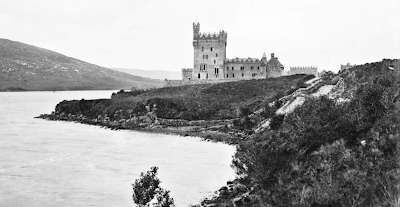The family of ADAIR was settled in Scotland, and later in Ulster, for many generations.
According to tradition, the family derived its descent from Thomas, 5th Earl of Desmond, who having gone on a hunting expedition, lost his way, and spent the night between Tralee and Newcastle, County Limerick, where he was received and hospitably entertained by William MacCormac, whose daughter he subsequently married.
At this alliance his family and clan were much offended, and compelled him to flee to France, and resign his title and estates to his younger brother in 1418.
He died of grief at Rouen, in 1420, where the two kings of England and France were present.
The 5th Earl of Desmond had issue, Maurice and John.
MAURICE had issue, Maurice and Robert.
ROBERT, returned to Ireland with the hope of regaining his family title and estates.
This Robert killed Gerald, the White Knight (second son of Gerald, the then Earl of Desmond), in single combat, at Áth Dara (ford of the oaks), County Limerick, but was subsequently defeated and fled to Scotland, where he assumed the name of ADAIRE.
GEORGE ADAIR JP DL (1784-1823), of Bellegrove, and Rath, Queen's County (son of John Adair, of Rath), wedded, in 1822, Elizabeth, second daughter of the Very Rev Thomas Trench, Dean of Kildare, and had an only son,
JOHN GEORGE ADAIR (1823-85), of Glenveagh Castle, County Donegal, who married Mrs Cornelia Wadsworth Ritchie, of Philadelphia, Pennsylvania, USA, widow of Montgomery Harrison Ritchie.
GLENVEAGH CASTLE, near Churchill, is described by Mark Bence-Jones thus:-
A Victorian-Baronial house of rough-hewn granite at the end of a wooded promontory jutting out into Lough Veagh, surrounded by the bare and desolate hills of a deer-forest, so large as to seem a world apart.The Castle comprises a keep with battlements, flanked by a lower round tower and other buildings. The entrance is through a walled courtyard.
The formal garden boasts terraces with busts and statuary; with a bathing pool by the side of the lough; an Italian garden; a walled garden with a Gothic orangery; and a splendid variety of rare and exotic trees and shrubs.
Glenveagh National Park lies in the heart of the Derryveagh Mountains in the north-west of County Donegal.
It is a remote and hauntingly beautiful wilderness of rugged mountains and pristine lakes.
The park, 40,000 acres in extent, consists of three areas.
The largest of these is the former Glenveagh Estate, including most of the Derryveagh Mountains.
The Glenveagh estate was created in 1857-9 by the purchase of several smaller holdings by John George Adair, a wealthy land speculator originally from County Laois.
Mr Adair was later to incur infamy throughout the county by evicting some 244 tenants in the Derryveagh evictions of 1861.
Adair, however, was never to fulfil his dream of creating a hunting estate in the highlands of Donegal and died suddenly in 1885 on return from a business trip to America.
After her husband’s death, Cornelia Adair took over the running of the estate and introduced deer stalking in the 1890s.
She continually sought to improve the Castle’s comforts and the beauty of its grounds, carrying out major improvements to the estate and laying out the gardens.
Over the next thirty years she was to become a much noted society hostess and continued to spend summers at the castle until 1916.
Following the death of Mrs Adair in London in 1921, Glenveagh fell much into decline and was occupied by both the anti-treaty and Eire army forces during the Irish civil war.
Glenveagh’s next owner was not to be until 1929 when purchased by Professor Arthur Kingsley Porter of Harvard University who came to Ireland to study Irish archaeology and culture.
The Porters mainly entertained Irish literary and artistic figures, including his close friend AE Russell whose paintings still hang in the library of the castle.
Their stay was to be short, however, as Arthur Kingsley Porter mysteriously disappeared from Inishbofin Island in 1933 while visiting the island.
The last private owner was Henry McIlhenny (1910-86), of Philadelphia, USA, who bought the estate in 1937.
Mr McIlhenny was an Irish-American whose grandfather, John, grew up in Milford, a few miles north of Glenveagh.
After buying the estate, McIlhenny devoted much time to restoring the castle and developing its gardens.
Eventually he began to find travelling to and from Ireland too demanding and the upkeep of the estate was also becoming a strain.
In 1975, he agreed the sale of the estate to the Irish government, allowing for the creation of a national park.
In 1983 he donated the castle to the Irish state, along with its gardens and much of the contents.
Glenveagh National Park opened to visitors in 1984, while the Castle itself opened in 1986.
First Published in February, 2012. Source: GLENVEIGH NATIONAL PARK.

























